Book Reviews
Book Reviews
FLYING BOATS
Air Travel in the Golden Age
By C Woodley
The History Press, The Mill, Brimscombe Port, Stroud, Gloucestershire GL5 2QG, UK. 2018. 197pp. Illustrated. £17.99. ISBN 978-0-75097014-3.
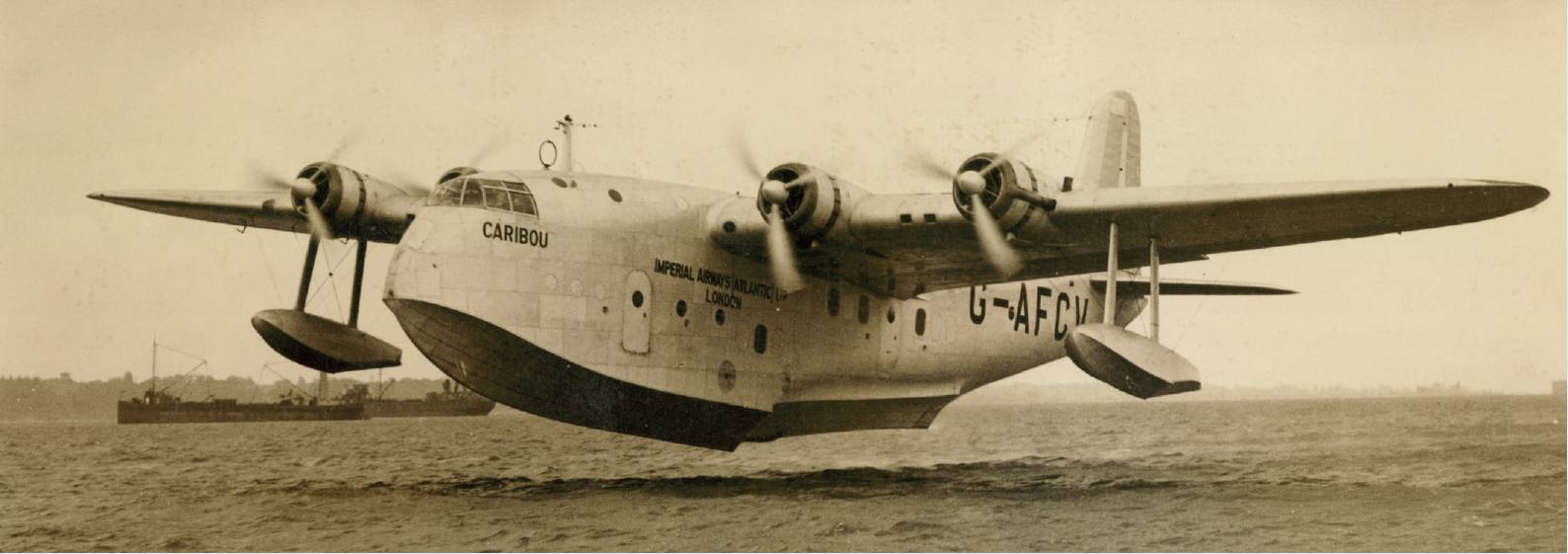 Short S.30 Empire Flying Boat, G-AFCV, Caribou. RAeS (NAL).
Short S.30 Empire Flying Boat, G-AFCV, Caribou. RAeS (NAL).
It is now some 80 years since Imperial Airways operated routes by Short C Class flying boats out of Southampton Water to the Empire and there will be few left alive today who can say that they experienced the luxury and service of these flights; we are literally speaking of a bygone age.
In his charming book describing ‘Air Travel in the Golden Age’, Charles Woodley has done a creditable job describing what it was like to fly as a passenger in these wonderful ‘boats which flew’ in which he has made good use of the archive material available, at least for the British flying boat era.
In his charming book describing ‘Air Travel in the Golden Age’, Charles Woodley has done a creditable job describing what it was like to fly as a passenger in these wonderful ‘boats which flew’
During the 1920s and 1930s of the past century, in terms of luxury a fair comparison could be made between air travel and that by sea, the former being simply a quicker mode of transport; both were used largely by government officials and by those with both the time and wealth to travel in this way.
Air travel expanded fairly rapidly after WW1 but only for relatively short journeys; airliners had low capacity and were constrained by the fact that there were few airports with facilities such as radio aids and proper runways of sufficient length for heavyweight take offs and landings. In contrast, most countries had sufficient coastlines with ports and infrastructure already in place. The Mediterranean countries were ideally situated in this way (Italy, in particular) and in developing the Empire routes to India and Africa it was a logical decision for Imperial Airways to operate flying boats from Brindisi to Alexandria before and after which land-based aircraft would provide the transport.
 Berths on Short S.23 Canopus. RAeS (NAL).
Berths on Short S.23 Canopus. RAeS (NAL).
However, the real catalyst to technical progress was probably the Empire Air Mail Scheme in which, from 1937, Imperial Airways would receive a subsidy to carry nearly all the mail to South Africa, India and Australasia at the same rate as surface mail which meant that frequencies and reliability would have to be improved. So it was with these two criteria in mind the airline approached Short Bros to submit a design which would not only carry the quantities of mail envisaged but also a reasonable load of passengers. The Short S.23 was the result in 1935, to be followed in due course by the S.30, the first two of a long line of derivations of the Short flying boats to fly the routes to the Empire.
The Short S.23 and S.30 are described in some detail, particularly in relation to the furnishings and, for passengers, it was clearly a wonderful experience. The procedure for passengers leaving the UK was that on the night before the flight they would travel down from London to Southampton by train (Pullman, of course) for a departure to Marseilles and Rome early the following morning. Many of the passengers kept diaries of their journeys or wrote letters describing the flights and service on board and the author makes good use of these.
In subsequent chapters the operations of these Short flying boats flown by Qantas and Tasman Empire Airways Limited (TEAL) are described in a similar way and it comes as a pleasant surprise to read that these operations carried on well into the 1950s and even the early 1970s with Ansett and RAI out of French Polynesia. Nearer home, Aquila Airways – the last airline in the UK to use flying boats exclusively – receives an honourable chapter and in a little more depth than some other airlines.
The author then goes on to describe the activities of other airlines of which Pan American was the most adventurous and, dare I say it, more innovative with their Sikorsky S-42, Martin M-130 and ultimately the Boeing 314. Pan American played in an entirely different garden to Imperial Airways and, under Juan Trippe, the airline built up an excellent network along both coastlines of South America with the S-42 and the subsequent expansion across the Pacific Ocean during the latter 1930s was determined and extraordinary. I feel that the activities of Ralph O’Neill could have received a mention here.
In Argentina, Dodero, ALFA, Aerolineas Argentinas and CAUSA of Uruguay all flew the Sandringham regionally making great use of the Parana and Uruguay rivers but these operations did not survive the early 1950s, largely because the countries involved had sound (and cheaper) land plane infrastructure.
The strength of this book lies in the chapters dealing with Imperial Airways, the Australasian scene and Aquila which follow a sound pattern. The other airlines receive more of a historical narrative rather than any real detail, possibly because there is less archive material easily available in this country and, while it is interesting, it would have been to some benefit to know more. An index would have been useful, too. And, of course, other countries also produced flying boats of some quality.
That said, so long as a reader purchases this book with that in mind, then it is a nice one to have on the shelf and it might lead the reader to seek more information.
Captain Dacre Watson FRAeS
INTRODUCTION TO AIR TRANSPORT ECONOMICS
From Theory to Applications – Third edition
By B Vasigh et al
Routledge, Taylor & Francis Group, 2 Park Square, Milton Park, Abingdon OX14 4RN, UK [20% discount available to RAeS members via www.crcpress.com using AKQ07 promotion code]. 2018. xxi; 498pp. £44.99. ISBN 978-1-138-23775-9.
Now in its third edition, this textbook retains essentially the same structure it had in earlier editions. Chapter headings are almost all the same. So what is different about the new volume? Quite a lot. First of all there is some extensive updating of relevant facts and figures in order to reflect some important changes that have taken place in the industry in the five years since the Second edition came out. The authors have gone to some trouble to compile new tables and draw new diagrams so that recent trends and developments are well illustrated. This is especially so in Chapter 1 on the advancement of the air transport industry, where good use of secondary source data is made in order to measure things like market concentration by the HirschmanHerfindahl Index.
Another major revision is in the form of end-of-chapter discussion questions which have been updated to reflect current issues. A valuable innovation is the inclusion of a new appendix providing suggested answers to these questions.
Overall this is a very good book: interesting, pleasant to read and highly instructive. It is clearly a most useful resource for students following courses in air transport economics
The chapter on economic principles has been expanded to indicate more closely how they might influence decisions made by airline managers in real-life situations. This also applies to the chapter on pricing and revenue management in which some interesting case studies and examples are used to explain topics like unbundling and ancillary revenues, market skimming and penetration pricing, peak-load pricing, discriminating fares and so on.
The important subject of forecasting is dealt with in Chapter 10, which is one of the more practical chapters in the book, containing as it does some brief explanations of various techniques which can be used in predicting traffic. This might perhaps seem a little ambitious, since many of the statistical techniques to which reference is made really require more in-depth treatment to make them useful in practice.
Low-cost carriers (LCCs) and the paradigm shift to which they have given rise are very neatly described in Chapter 12. This covers the development of ‘ultra’ LCCs but says little or nothing about the increasing emergence of LCCs on long-haul routes, although the chapter does start with a quote from the CEO of Norwegian Air, one of the airlines attempting to develop long-haul low-cost services.
A similar criticism might be made of Chapters 6 and 7, which cover international economics and Open Skies. There is a lack of any detailed discussion on the rather fierce debate taking place in the airline industry on liberalisation versus mercantilism and in particular on the dispute between the three largest airlines in the US (American, Delta and United) and the big three in the Persian Gulf (Emirates, Etihad and Qatar Airways). Resolving differences of this kind are not simply questions for the countries and airlines principally involved but has far-reaching implications for the development of the industry worldwide.
Overall this is a very good book: interesting, pleasant to read and highly instructive. It is clearly a most useful resource for students following courses in air transport economics. It may also appeal to a wider readership of people working in and around the industry. There is much to be learnt from it.
Dr J P Hanlon
HONEST VISION
The Donald Douglas Story
By J Filucci
Aviation Supplies & Academics, Inc, 7005 132nd Place SE, Newcastle, WA 98059, USA. 2018. xi; 308pp. Illustrated. $19.95. ISBN 978-1-61954406-2.
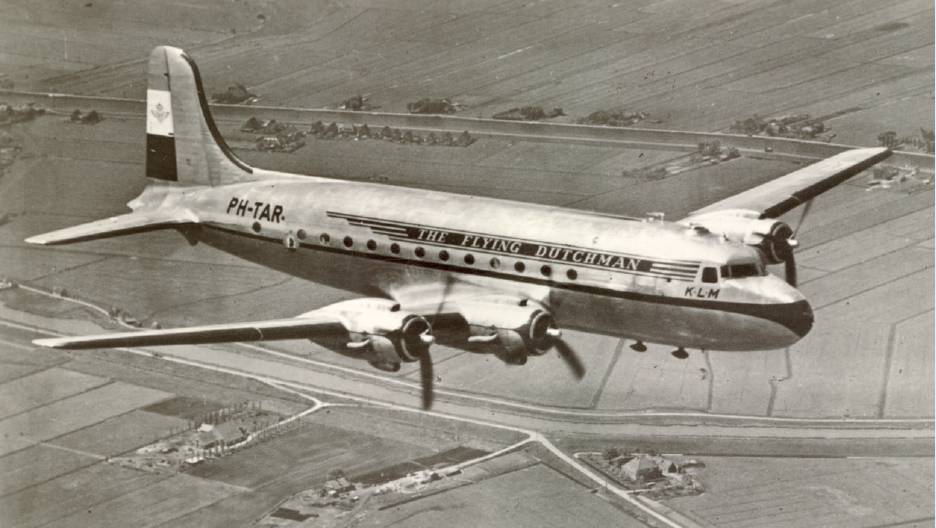 A Douglas DC-4 of KLM, PH-TAR, Rotterdam. The DC-4/C-54 proved a popular and reliable aircraft, 1,245 being built between May 1942 and August 1947. RAeS (NAL).
A Douglas DC-4 of KLM, PH-TAR, Rotterdam. The DC-4/C-54 proved a popular and reliable aircraft, 1,245 being built between May 1942 and August 1947. RAeS (NAL).
Successful biographers need to immerse themselves in the essentiality of their chosen subjects, something Julie Filucci has clearly achieved with her wide-ranging study of Donald ‘Doug’ Douglas, founder of the Douglas Aircraft Company and icon of the early aviation industry.
Her account begins with the path taken by Douglas from a relatively modest background, like so many early constructors on both sides of the Atlantic. In 1912 after being one of the first aeronautical engineering students at the upstart Massachusetts Institute of Technology, he took on short-term posts with the Connecticut and Glenn Martin aircraft companies until, during WW1, he became chief civilian aeronautical engineer with the US Signal Corp’s aviation section. At its end he returned to Glenn Martin where he worked on designing a twin-engined heavy bomber that he believed could be adapted for the potentially vast commercial market.
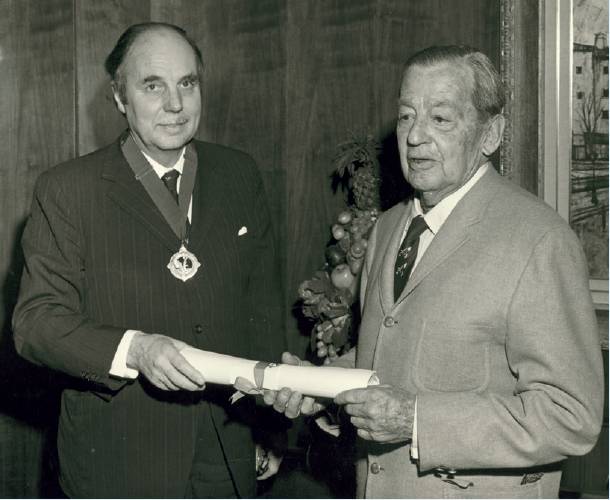 Dr George Hislop (left), RAeS President 1973-1974, presenting Donald Wills Douglas Sr (1892-1981) with his RAeS Honorary Fellowship in February 1974. RAeS (NAL).
Dr George Hislop (left), RAeS President 1973-1974, presenting Donald Wills Douglas Sr (1892-1981) with his RAeS Honorary Fellowship in February 1974. RAeS (NAL).
In her easy style Filucci tells us about Douglas’s dream of “giving life to something that has a profound impact on the life of all mankind” that could only be achieved through starting his own firm. He decided to base it in the favourable climate of Southern California into which he sank his young wife’s and his own total savings of $26,000 and where he would soon be joined by many of his previous most able work colleagues.
From 1920 onwards the fledgling company would make startling progress by supplying aircraft to the US military through which it earned such high-profit margins that the Depression of 1929 did not affect it. The next leap forward came when, in 1932, it obtained an option from Trans-Continental and Western Airline (the forerunner to TWA) to build a total of 60 twin-engined commercial passenger aeroplanes with advanced design features. These had the designation DC-1 (Douglas Commercial One) with the DC-2 following and the process culminating in the famed DC-3 (Dakota) that came to symbolise the superiority of American aviation. Thoroughgoing scientific tests conducted by Douglas on the aircraft enabled it to achieve the required level of reliability and strength for a passenger aircraft designed to transport cargo and passengers across remote areas. The peak of success came when, during WW2, the Dakota subsequently became the US military’s legendary workhorse, with more than 10,000 produced (Its only contemporary rival for the title of the most famous transport aircraft of all time was the German Junkers Ju52 which required servicing after every 500 hours flight compared to the DC-3’s 1,500 hours).
For a biographer, recounting success is arguably not that difficult but when she describes a man who follows a remarkably set regime of life, we sense that some trouble is overdue. She tells us how he famously always ate breakfast of one egg, one piece of white toast and one cup of black coffee, how he left for his factory at 9, worked in his walnut-panelled office until 12 noon, when he had his habitual lunch before returning home at 5.30 where dinner was always taken at 6.30 and always included a chocolate sundae, and how he passed every evening alone in his library while his wife listened to the radio elsewhere with his relaxation coming with time spent every weekend on his yacht.
Julie Filucci’s account reveals how Douglas’s genius as an aeronautical innovator contrasts with his human frailties
After WW2 things did became far more complicated and Filucci recounts how Douglas suffered a series of setbacks. With flexibility not Douglas’s strong suit, his unyielding standards of construction practice combined with marked financial conservatism led him to miss significant business opportunities while his unswerving filial loyalty to a son lacking his calibre, brought inevitable crises.
The picture becomes steadily adverse during the 1950s and early 1960s as events moved against Douglas when he rejected supersonic jet transport in favour of pushing into space. Despite producing weapons like the Honest John surface-to-surface missile, the Thor ICBM and the Skybolt ballistic missile, frenetic competition with the Soviets brought unexpected and repeated cancellations. The problems of allocating resources between aeroplanes and missiles also led the company to be outmanoeuvred by rival constructor Boeing whose 707, 727 and 737 aircraft models overtook Douglas’s DC-8s and DC-9s in both sales and delivery times resulting in the company eventually becoming bankrupt and being taken over by James McDonnell.
Julie Filucci’s account reveals how Douglas’s genius as an aeronautical innovator contrasts with his human frailties – about which she is studiously non-judgemental – ranging from his mental rigidity, falling short in personal relationships and his long-time deception of his wife with his mistress Peggy Tucker.
An absorbing read about one of America’s aviation giants during the course of which the reader gains insights into the immense opportunities and near unfettered competition within the US aviation industry which undoubtedly helped it assume its dominant position on the world stage.
Peter Reese AMRAeS
APOLLO IN PERSPECTIVE
Spaceflight Then and Now – Second edition
By J Allday
CRC Press, Taylor & Francis Group, 6000 Broken Sound Parkway NW, Suite 300, Boca Raton, FL 33487-2742, USA. 2019. Distributed by Taylor & Francis Group, 2 Park Square, Milton Park, Abingdon OX14 4RN, UK. xvi; 232pp. £29.99. [20% discount available to RAeS members via www.crcpress.com using AKQ07 promotion code]. ISBN 978-0-367-26333-1.
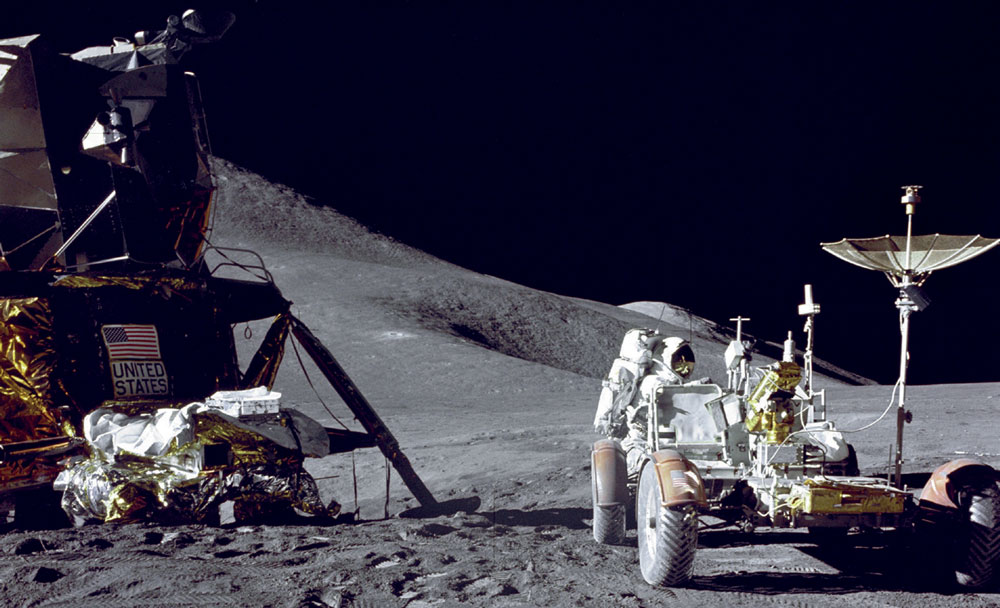 Apollo 15 Lunar Module pilot James B Irwin loads-up the Lunar Roving Vehicle (LRV) with tools and equipment in preparation for the first lunar extravehicular activity (EVA-1) at the Hadley-Apennine landing site, 31 July 1971. NASA.
Apollo 15 Lunar Module pilot James B Irwin loads-up the Lunar Roving Vehicle (LRV) with tools and equipment in preparation for the first lunar extravehicular activity (EVA-1) at the Hadley-Apennine landing site, 31 July 1971. NASA.
Apollo in Perspective occupies an enjoyable space somewhere between an academic textbook and a narrative history. The book provides a sound introduction to the basics of rocketry and orbit dynamics in the context of the Apollo programme. It does much more than that though. The reader is given a well-paced, informative and anecdotally rich tour of the systems that came together to make the Moon landings possible.
The rationale for each of the missions is explained, along with key events, advances and problems encountered. Important elements of the complete Moon landing system are described – from flight computers to Moon suits – as well as their origins in early programmes like Mercury and Gemini.
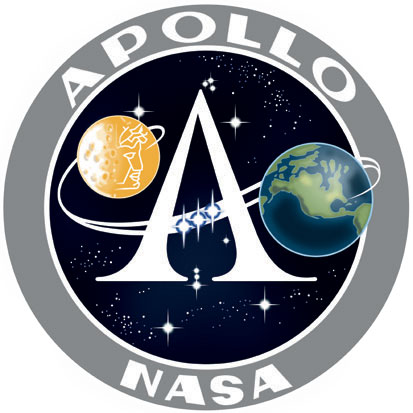 Following on from the Apollo programme, the book goes on to provide a tour through subsequent US space programmes, including the Space Shuttle and the current efforts to re-establish a human launch capability able to reach the Moon and beyond.
Following on from the Apollo programme, the book goes on to provide a tour through subsequent US space programmes, including the Space Shuttle and the current efforts to re-establish a human launch capability able to reach the Moon and beyond.
This book is suitable for browsing as well as cover-to-cover reading. It will be of interest to students of science and engineering, space enthusiasts and any with an interest in the history of technology. If you’ve ever wondered how the lunar rovers were stowed in the lander, how the on-board computer worked or if there ever was a place called Cape Kennedy – then you will get good value from this book. The present 50-Year Anniversary Edition includes updates as of 2019, reflecting the current status of the US Artemis ‘Return-to the-Moon’ programme.
Richard Lowe MRAeS
 Short S.30 Empire Flying Boat, G-AFCV, Caribou. RAeS (NAL).
Short S.30 Empire Flying Boat, G-AFCV, Caribou. RAeS (NAL). Berths on Short S.23 Canopus. RAeS (NAL).
Berths on Short S.23 Canopus. RAeS (NAL).


